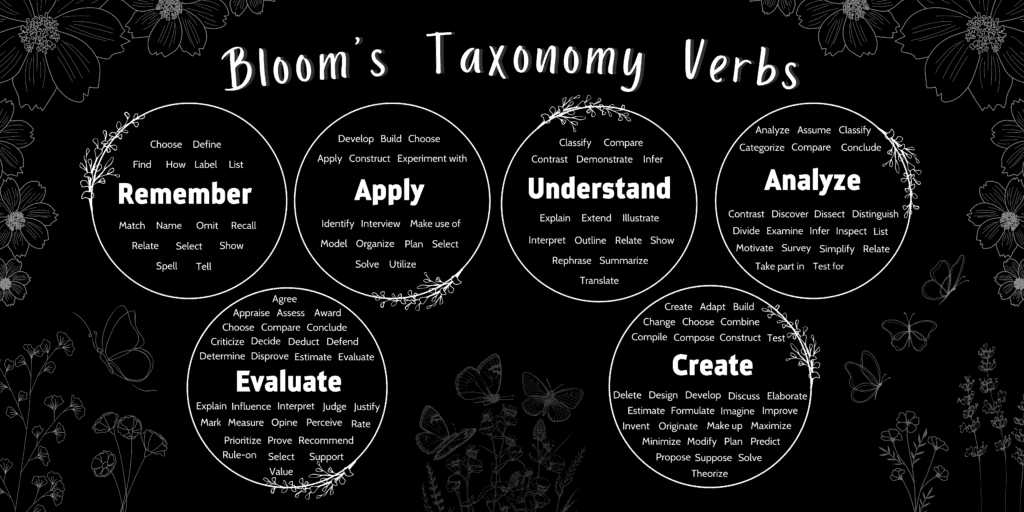Have you ever heard this saying?
Begin with the end in mind.
When designing or selecting professional training, beginning at the beginning can be an expensive place to start and prove to be a waste of valuable time. Skilled trainers know where they’re headed as they begin the design process. They develop learning objectives to achieve specific results. But beware, not all learning objectives are equal! In a previous blog, we made the case for developing purposeful, clear, and measurable learning objectives. Bloom’s Taxonomy can help you develop those objectives and create effective training. We’ll show you how you can use this powerful tool to plan with the end in mind!
Quick Knowledge Quiz
Where do you begin?
Begin at the end.
Ask: What do your learners need to be able to do?
Know something? (Remember)
Comprehend something they know? (Understand)
Make use of knowledge? (Apply)
Motivate our team? (Analyze)
Rearrange or integrate something? (Evaluate)
Develop or construct something? (Create)

Let’s seek to understand each level of Bloom’s Taxonomy
Remember
Think of the first level as the Reddit version of skills. Is it most important to just know something cognitively so it can be restated later? Fully comprehending the details and being able to apply the knowledge is not important. Our goal is simply knowing, recalling, or recognizing something. For example, it might be important to know what a budget is, and the difference between income and expenses.
Understand
The second level is slightly past the Reddit version of skills. Understanding means being able to comprehend, interpret, explain, compare, contrast, or summarize something. It’s more than just knowing. This level is when it’s necessary to be able to extend, classify, outline, explain, discuss, and effectively rephrase the knowledge gained. For example, it’s important to be able to understand that work generally leads to income, and with a budget you can classify the difference between income and expenses.
Apply
The next level takes the knowledge you have and brings it into your world, your work, or your life in a meaningful way. This is more than just knowing; it’s doing. This is the level of learning at which you are required to make use of the knowledge you’ve gained in order to plan, construct, develop, organize, or solve things. Building a budget is a good example.
Analyze
The fourth level requires getting into the details of why things are the way they are and connecting similar concepts and ideas. Categorizing, examining, testing theories, as well as simplifying or selecting, fall into this level. A good example here is examining what happened and identifying the causes for when your budget doesn’t work exactly as planned.
Evaluate
Once knowledge has been gained, understood, applied, and analyzed, then it can be evaluated, and a decision or conclusion can be made. At this point it becomes appropriate to learn how to justify, defend, and explain the decision or conclusion. This is the level of learning required to do a performance evaluation or assessment, influence a team, or prioritize your tasks.
Create
Creating is the highest level of knowledge. At this level, you’ve gone through all the prior levels, and you’re creating something that didn’t exist before. This is where change and design occur. This is where problems are solved, and inventions are formulated. The creation of art, technology, architecture, and even relationships, fall into this category.
Next, evaluate these learning verbs
Which one of these fits with your learning goals?
| Remember | Understand | Apply | Analyze | Evaluate | Create |
| Choose | Classify | Apply | Assume | Agree | Adapt |
| Define | Compare | Build | Categorize | Appraise | Build |
| Find | Contrast | Choose | Classify | Assess | Change |
| How | Demonstrate | Construct | Compare | Award | Combine |
| Label | Explain | Develop | Conclude | Choose | Compile |
| List | Extend | Experiment with | Contrast | Compare | Design |
| Match | Illustrate | Identify | Discover | Conclude | Develop |
| Name | Infer | Interview | Distinguish | Criticize | Discuss |
| Omit | Interpret | Make use of | Examine | Decide | Formulate |
| Recall | Outline | Model | Infer | Deduct | Imagine |
| Relate | Relate | Organize | Inspect | Defend | Improve |
| Select | Rephrase | Plan | List | Determine | Maximize |
| Show | Show | Select | Motivate | Disprove | Minimize |
| Spell | Summarize | Solve | Relate | Estimate | Modify |
| Tell | Translate | Utilize | Simplify | Evaluate | Plan |
| Survey | Explain | Predict | |||
| Test for | Interpret | Propose | |||
| Justify | Solve | ||||
| Recommend | Test |
And finally… create!
Once you KNOW what you’re trying to accomplish through training (Remembering, Understanding, Applying, Analyzing, Evaluating, or Creating) you can begin to CREATE course or learning objectives that equip your learners to apply knowledge effectively, guide them toward higher-order skills, and foster critical thinking.
Or let us do it for you…
Once you have a clear idea of what you’re looking for in training, rather than spending the time building your own course content, feel free to check out ours. We have clear objectives, so you’ll know exactly what to expect. Here’s a link to our course catalog.
Bloom’s Taxonomy Bloom’s Taxonomy Bloom’s Taxonomy Bloom’s Taxonomy



